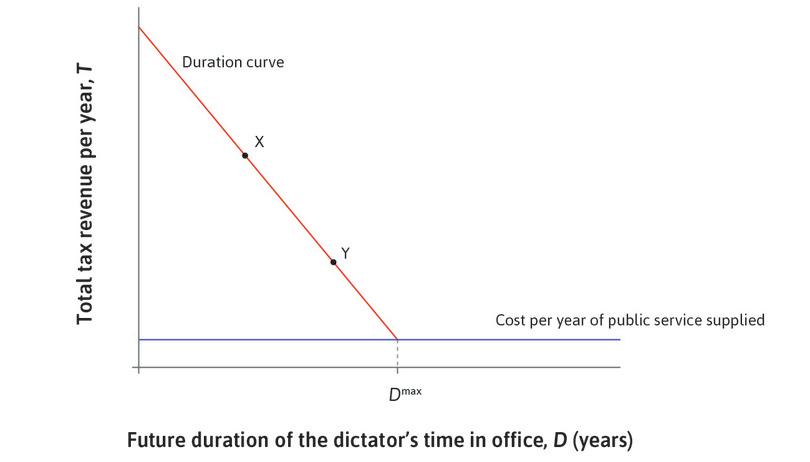Leibniz
22.2.1 Expected duration of the dictator or governing elite
The higher the annual tax revenue collected by the dictator, the greater the probability that he will be dismissed and the shorter the time for which he can expect to remain in office. In this Leibniz we derive the relationship between tax revenue and expected duration—the duration curve—mathematically.
The dictator may be dismissed for poor performance (the political rents that he collects in taxes above the cost of providing the public good) or for reasons unrelated to performance. We will denote the probability of dismissal in any year for performance reasons as . The higher the annual tax collected, , the higher the probability of dismissal. In other words, is an increasing function of , so we will write it as . If we denote the probability of dismissal for unrelated reasons by , then the probability of being dismissed in any year for any reason, denoted as , is the sum of these two probabilities:
Strictly speaking, this is an approximation, because we are ignoring the possibility that the performance and other reasons might both arise in the same year. But it is a good approximation provided that the probabilities and are not high.
Assume that once the dictator has set his level of taxation he does not change it, and nothing else changes over time, so the dismissal probability remains constant, irrespective of how long he has already been in office. Suppose that his expected duration of office at the beginning of the current year is years, and if he survives this year (which occurs with probability ), then at the beginning of the next year his expected duration will be years. The duration this year is one plus the expected additional duration in future:
But if the dictator makes it through this year, the chances of dismissal will be exactly the same at the beginning of next year as they are now. So the expected duration at the beginning of next year will be exactly the same as it was this year. Hence and
We solve this equation for to obtain , or equivalently:
This is the equation of the duration curve illustrated in Figure 22.5 in the text, reproduced below as Figure 1. It is drawn with on the horizontal axis. Since is an increasing function of , decreases with , so the curve slopes downward. The shape of the curve depends on the form of the function , but for simplicity it is shown here as a straight line.
When the tax revenue just covers the cost of public services, , the dictator is collecting no political rents, in which case we assume that he will not be dismissed for performance reasons, and . So his maximum expected duration of office, , occurs when and is thus given by:

